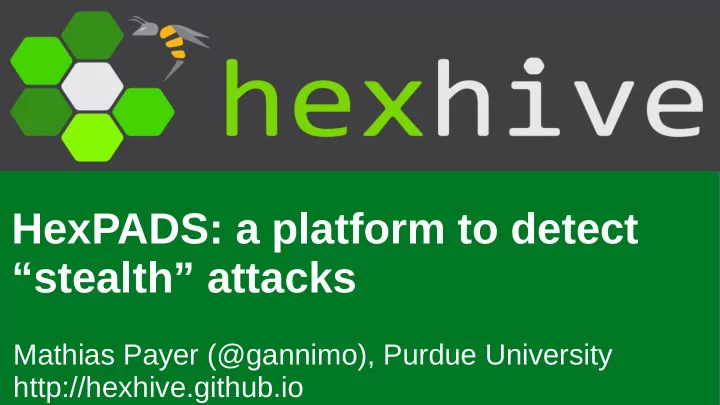

HexPADS: a platform to detect “stealth” attacks Mathias Payer (@gannimo), Purdue University http://hexhive.github.io
Deployed defenses focus on memory corruption (c) AP Photo/RIA Novosti, Alexei Druzhinin, Government Press Service
(c) National Nuclear Security Administration, 1953
Consider program state and behavior
HexPADS Design
HexPADS Design ● Host-based Intrusion/Attack Detection System PMU ● Measure fine-grained process-level CPU runtime behavior Operating system provides basic – runtime characteristics OS Performance Monitoring Unit (PMU) – allows counting/sampling of detailed and fine-grained events ATTACK PROC PROC PROC PADS ● Detect attacks based on signatures/anomalies ● Take evasive action/counter measure
Default Metrics (always collected) ● Number of executed instructions ● Number of last level cache accesses ● Number of last level cache misses ● Minor/major page faults ● Execution time (c) Intel
Additional Metrics ● Anything in /proc – Opened files, network ports, and IPC – Loaded libraries – Memory maps ● Any measurable PMU event – Memory/cache hierarchy events – Instruction mix and behavior – Execution profile and branch records ● System calls
Implementation ● Modular implementation ● Collect metrics for all processes ● Keep configurable history ● Run detection modules every iteration http://github.com/HexHive/HexPads
Evaluation
SPEC CPU2006 No measurable overhead 450 400 350 300 Runtime in seconds 250 200 Idle 150 PADS 100 50 0
Rowhammer ● Cause DRAM bit flips by accessing adjacent cells – High amount of cache misses: > 500,000/s – High cache miss rate: > 70% – Low page fault rate: < 1% ● Possible extension: use sampling – Detect and correlate actual accesses – Detect “nearby” accesses
Cache-based side/covert channels ● Communicate through access timing – Same pattern as rowhammer – Additional challenge: which process is bad? ● Possible extension: longer history – Consider development over time
Cross-VM ASL INtrospection (CAIN)* ● CAIN attacks leak ASLR base addresses in co-located VMs – High amount of page faults/allocated pages/cache misses/per instr. – Followed by inactivity ● Possible extension: study access patterns – Push detection to VMM level – Check page similarity – Evaluate page access patterns CAIN: Silently Breaking ASLR in the Cloud. Antonio Barresi, Kaveh Razavi, Mathias Payer, and Thomas R. Gross. In WOOT '15
Upcoming Challenges ● Move collection to VMM to allow per-machine correlation ● Extend and develop new detection modules ● Synthesize detection modules by applying machine learning PMU CPU OS ATTACK PROC PROC PROC PADS
Conclusion
Conclusion ● HexPADS is a modular IDS/ADS framework ● Process-based collection of runtime/performance information ● High precision and negligible overhead through PMU ● Ongoing work: – More detection modules – Machine learning – Push framework to VMM level ● Go clone the project at https://github.com/HexHive/HexPADS
Thank you! Questions? Mathias Payer (@gannimo), Purdue University http://hexhive.github.io
Recommend
More recommend